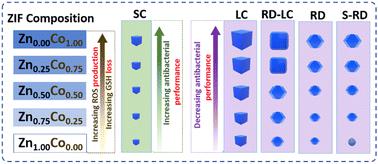当前位置:
X-MOL 学术
›
New J. Chem.
›
论文详情
Our official English website, www.x-mol.net, welcomes your feedback! (Note: you will need to create a separate account there.)
Morphology-size map of zeolitic imidazolate frameworks: unveiling the bactericidal effects upon varying their zinc/cobalt ion contents
New Journal of Chemistry ( IF 2.7 ) Pub Date : 2024-07-12 , DOI: 10.1039/d4nj01963f Ruth Antwi-Baah 1 , Malcom Frimpong Dapaah 2 , Yajing Wang 3 , Xiaoqin Chen 3 , Heyang Liu 4, 5
New Journal of Chemistry ( IF 2.7 ) Pub Date : 2024-07-12 , DOI: 10.1039/d4nj01963f Ruth Antwi-Baah 1 , Malcom Frimpong Dapaah 2 , Yajing Wang 3 , Xiaoqin Chen 3 , Heyang Liu 4, 5
Affiliation

|
Zeolitic imidazolate frameworks (ZIFs) show promise in fighting bacterial resistance, yet crucial gaps in research hinder their clinical use. For the first time, through meticulous exploration, we unravel the correlation between the size, shape, and zinc/cobalt ion content of 25 ZIF variants and their antibacterial performance in addition to their mechanism pattern, giving special focus to oxidative stress. Notably, a novel morphology-size map of the 25 different ZIFs is established under five main groups namely, small cubes (SC), large cubes (LC), rhombic dodecahedron-large cubes (RD-LC), rhombic dodecahedron (RD), and spherical-rhombic dodecahedron (S-RD) ZIFs. The antibacterial experiments against Staphylococcus aureus showed that ZIFs in the SC group with higher cobalt content had the lowest minimum inhibition concentration (MIC) of 12.5 μg mL−1. Conversely, increased zinc content yielded better antibacterial activity for the other groups. Furthermore, our investigation into the mechanisms revealed cobalt's crucial role in fostering reactive oxygen species (ROS) accumulation, correlating with glutathione (GSH) depletion. Remarkably, the differential responses of ZIF-8 and ZIF-67 to the antioxidant N-acetyl cysteine (NAC) shed light on nuanced pathways governing antibacterial performance. While ZIF-8 demonstrated reduced efficacy, the antibacterial performance of ZIF-67 remained either sustained or modestly improved under antioxidant conditions. Overall, these findings not only enrich our comprehension of ZIFs but also propel their potential for targeted antibacterial interventions, thereby fostering confidence in their clinical translation.
中文翻译:

沸石咪唑酯骨架的形态尺寸图:揭示不同锌/钴离子含量的杀菌效果
沸石咪唑酯框架(ZIF)在对抗细菌耐药性方面表现出良好的前景,但研究中的重大差距阻碍了其临床应用。通过细致的探索,我们首次揭示了 25 个 ZIF 变体的大小、形状和锌/钴离子含量与其抗菌性能以及其机制模式之间的相关性,特别关注氧化应激。值得注意的是,在五个主要组下建立了 25 种不同 ZIF 的新颖形态尺寸图,即小立方体 (SC)、大立方体 (LC)、菱形十二面体-大立方体 (RD-LC)、菱形十二面体 (RD)、和球菱形十二面体 (S-RD) ZIF。对金黄色葡萄球菌的抑菌实验表明,钴含量较高的SC组ZIFs的最低抑菌浓度(MIC)最低,为12.5 μg·mL −1 。相反,增加锌含量对其他组产生更好的抗菌活性。此外,我们对机制的研究揭示了钴在促进活性氧(ROS)积累方面的关键作用,与谷胱甘肽(GSH)消耗相关。值得注意的是,ZIF-8 和 ZIF-67 对抗氧化剂 N-乙酰半胱氨酸 (NAC) 的不同反应揭示了控制抗菌性能的微妙途径。虽然 ZIF-8 的功效有所降低,但 ZIF-67 的抗菌性能在抗氧化条件下仍然持续或略有改善。总体而言,这些发现不仅丰富了我们对 ZIF 的理解,而且还增强了它们进行靶向抗菌干预的潜力,从而增强了对其临床转化的信心。
更新日期:2024-07-16
中文翻译:

沸石咪唑酯骨架的形态尺寸图:揭示不同锌/钴离子含量的杀菌效果
沸石咪唑酯框架(ZIF)在对抗细菌耐药性方面表现出良好的前景,但研究中的重大差距阻碍了其临床应用。通过细致的探索,我们首次揭示了 25 个 ZIF 变体的大小、形状和锌/钴离子含量与其抗菌性能以及其机制模式之间的相关性,特别关注氧化应激。值得注意的是,在五个主要组下建立了 25 种不同 ZIF 的新颖形态尺寸图,即小立方体 (SC)、大立方体 (LC)、菱形十二面体-大立方体 (RD-LC)、菱形十二面体 (RD)、和球菱形十二面体 (S-RD) ZIF。对金黄色葡萄球菌的抑菌实验表明,钴含量较高的SC组ZIFs的最低抑菌浓度(MIC)最低,为12.5 μg·mL −1 。相反,增加锌含量对其他组产生更好的抗菌活性。此外,我们对机制的研究揭示了钴在促进活性氧(ROS)积累方面的关键作用,与谷胱甘肽(GSH)消耗相关。值得注意的是,ZIF-8 和 ZIF-67 对抗氧化剂 N-乙酰半胱氨酸 (NAC) 的不同反应揭示了控制抗菌性能的微妙途径。虽然 ZIF-8 的功效有所降低,但 ZIF-67 的抗菌性能在抗氧化条件下仍然持续或略有改善。总体而言,这些发现不仅丰富了我们对 ZIF 的理解,而且还增强了它们进行靶向抗菌干预的潜力,从而增强了对其临床转化的信心。












































 京公网安备 11010802027423号
京公网安备 11010802027423号